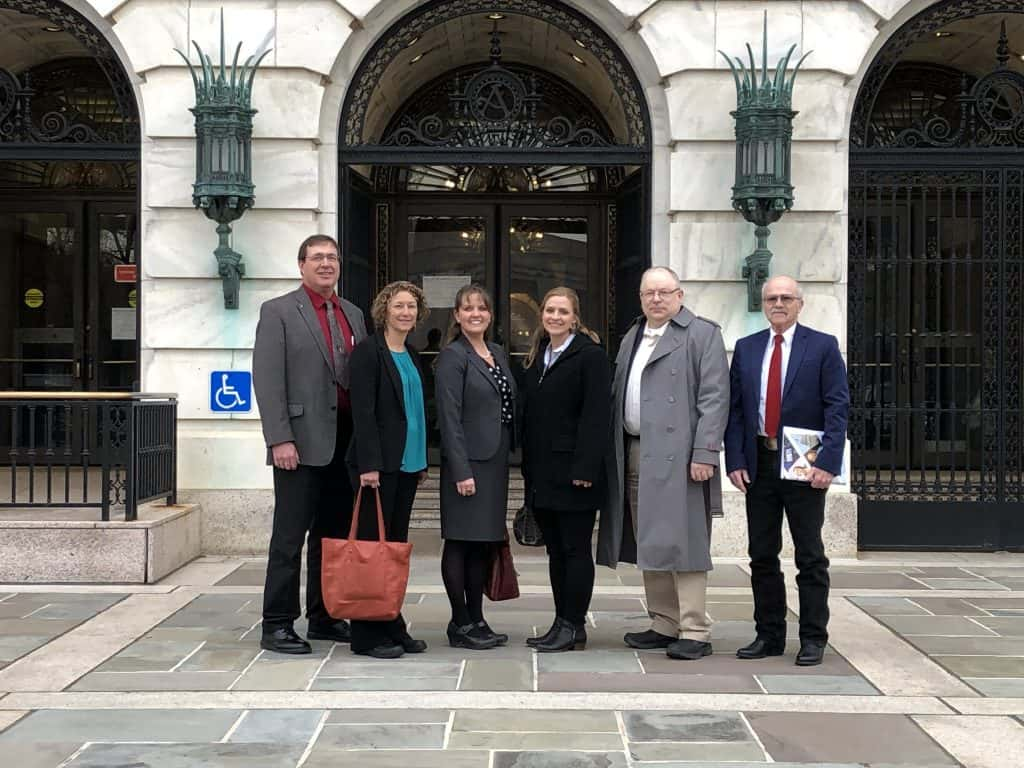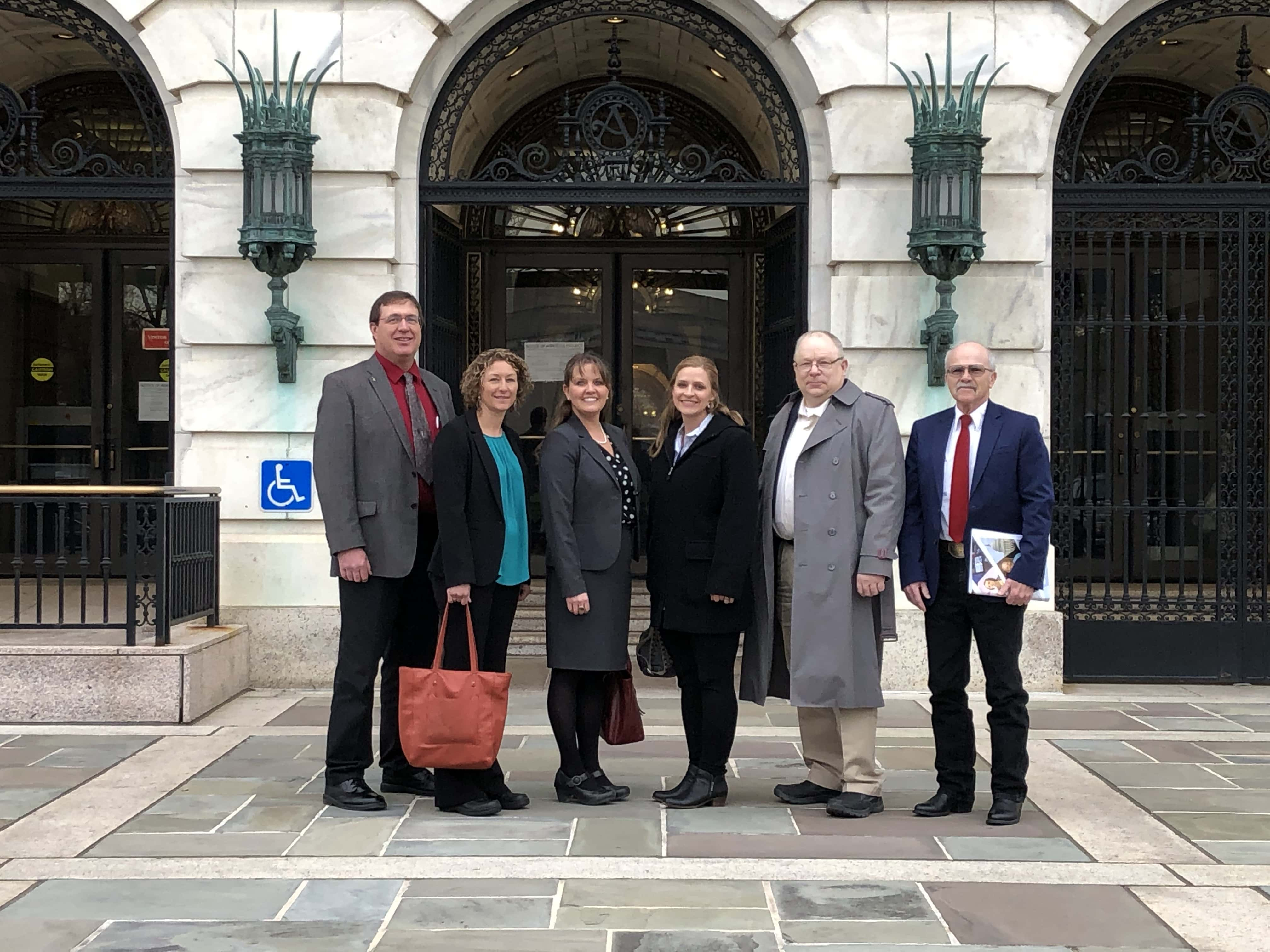Montana Farm Bureau members were back in the nation’s capital February 20-21, this time for American Farm Bureau’s Issues Advisory Committee meetings as well as meeting for the second time in two weeks with legislative offices and agencies. The IAC meetings at the association’s headquarters in Washington, D.C. brought farmers and ranchers together from across the state to discuss issues of concern. MFBF had members on five committees: Animal Care, Environmental Regulations, Farm Policy, Federal Lands and Water.
Tonya Liles, a cattle rancher from Terry, explained to the Animal Care Committee strong concerns regarding feral hogs’ entry into Montana. She discussed bison and the threat of brucellosis to Montana cattle across the state if a “wild” or “free-roaming” herd is ever established outside Yellowstone National Park.”
There was talk about the Hours of Service/Electronic Logging Devices to include a 150-mile exemption not only from the beginning of a haul but 150 miles from the destination. “We are concerned about livestock being unloaded because the trucker has reached the driving time limit. Having to unload animals unnecessarily will increase stress for the animal as well as increase the risk of injury and disease.”
Megan Hedges, who serves on the Farm Policy Committee, talked about one FDA report that caused the pulse crop market to tank overnight. “We had a great market for our pulse crops in the pet food industry; but the moment the FDA released a report that said pulses cause heart problems in dogs, all the food got pulled off the shelves and the market tanked,” said pulse crop farmer from Chester. “We’re looking for ways to resolve that as well as get new markets for pulses and are hoping President Trump’s visit to India bodes well for trade. In addition, we talked about disaster payments and the need in the next farm bill to provide sufficient crop insurance.”
The prevailing theme of the Water Committee was water quality. One presentation featured a computer program that can assess an irrigated area and determine the nutrient value. “This could certainly help a farmer determine ways to keep more nutrients in their soil, saving them money and improving soil quality,” said Mike Murphy, a rancher from Wolf Creek. “We discussed how agriculture gets blamed for algae bloom when it’s a combination of factors; in fact, in some places where there is algae bloom there is no agriculture.”
Don Steinbeisser, Jr. said feral hogs, predatory black vultures and others detrimental creatures were the topic of discussion in the Environmental Regulations Committee. “A lot of ranchers are losing calves and fish to the black vultures, but they’re considered a protected species; depending on the state, you can get permits to kill them if they’re harming your livestock/fish.”
The committee learned about the Lake Erie Bill of Rights (LEBOR), a ballot initiative in Toledo, Ohio, that passed, establishing “irrevocable rights for the Lake Erie Ecosystem to exist, flourish and naturally evolve.”
“Obviously this is a real concern for farmers, ranchers and landowners because we believe lakes can’t have rights, and this could lead to frivolous lawsuits against farmers—although LEBOR is being challenged in court now,” said Steinbeisser, a Sidney sugar beet farmer. “It’s important to share information about what we learn at these meetings with our county Farm Bureaus so we can develop good policy.”
Discussions in the Federal Lands Committee, consisting mostly of western states, covered the recent scoping meetings for revisions in grazing permits, managing equine under the Wild Horse & Burro Act and discussing migratory bird corridors.
Tom DePuydt, a Saco cattle rancher, noted, “The Federal Lands Committee also talked about forest fires and the need for local control of them along with more accountability from the government when it comes to fighting fires. We discussed reforms to the National Environmental Policy Act, especially making the process more streamlined; right now, those NEPA regulations are 15,000-20,000 pages.”
In addition to IAC meetings, members toured the White House, met with the external affairs director at the U.S. Department of Agriculture and visited with staff at all three Congressional offices.
“Montana Farm Bureau believes it’s extremely important to have farmers and ranchers from Montana serving on these advisory committees. While many agriculture issues are relevant and similar nationwide, there are others that are more important in certain regions or have slightly different implications. We like to make sure the western perspective is shared. We can all learn from each other and get a lot more done when we work together,” said MFBF National Affairs Director, Nicole Rolf. “Additionally, there is tremendous value in having our members in D.C. to share their first-hand knowledge and expertise on agriculture with our elected officials, staff, and agency personnel.”

(Montana Farm Bureau members in front of the U.S. Department of Agriculture, Washington, D.C. (left to right): Tom DePuydt, Tonya Liles, Nicole Rolf, Megan Hedges, Don Steinbeisser, Jr. and Mike Murphy.)
###
MFBF


